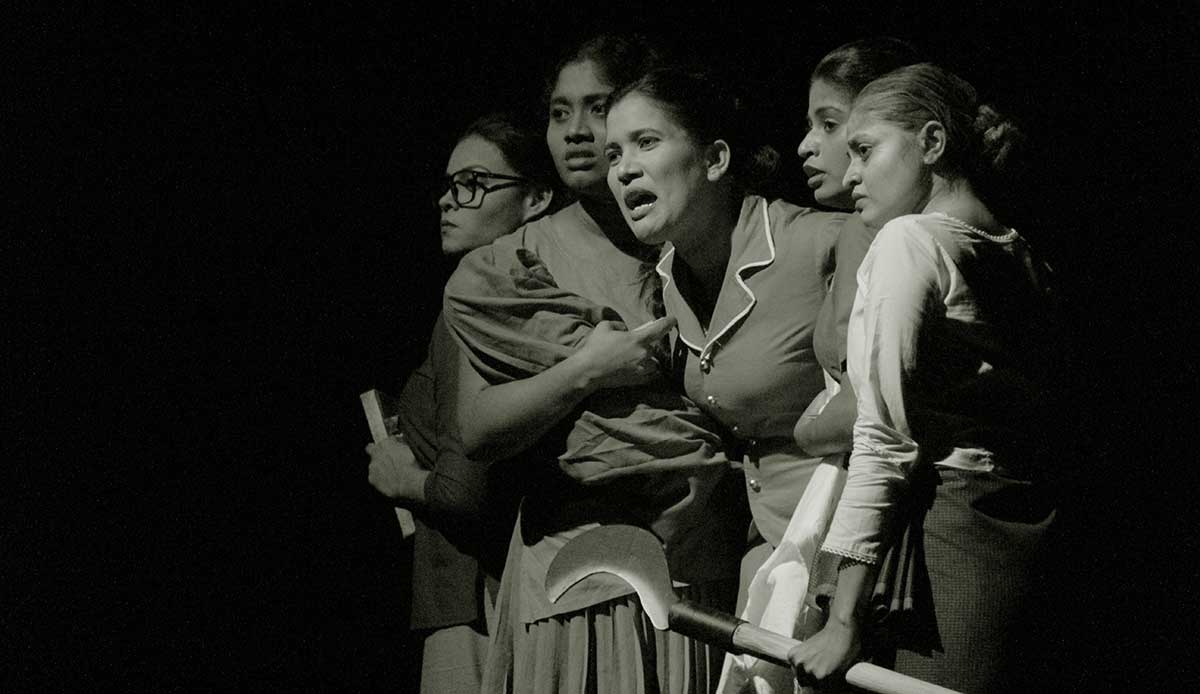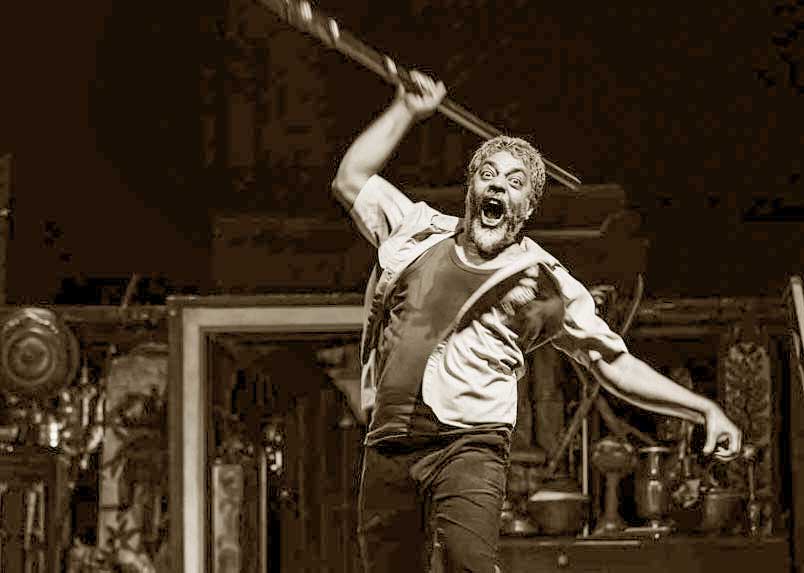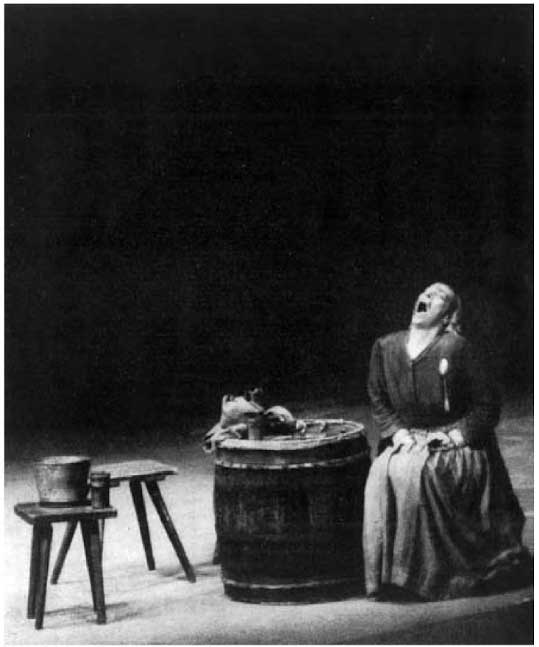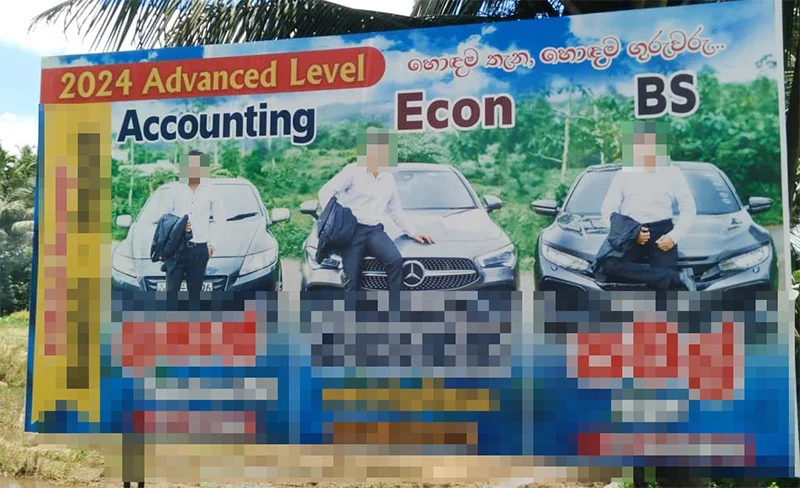Features
Photography: A Primitive Theatre

BY Saumya Liyanage
(Text of a keynote address delivered at the annual Diploma Certificate Award Ceremony, organised by the National Photographic Art Society, Sri Lanka, on the 26 October 2024)
When a photograph of the main protagonist, Joseph, in the play Antique Kadayaka Maranayak (‘Death in an Antique Shop’), written and directed by Asoka Handagama, was shared on Facebook, a much awaited discussion erupted among theatregoers on how this image captured the true essence of the play. The playwright and director Handagama had also commented on Facebook, stating that the photographer, Sagara Lakmal de Mel, has captured the ‘full coverage of the play’ (Handagama, Facebook, 4th June 2023). This statement and the comments received for the Facebook post aroused a question of how photography links with theatre. How could a still image depict the essence of a play? Why is a still image of a play so important for us to understand the nature of acting, mise en scène, and other aspects of theatre?
Theatre photography has not been a major interest of the Sri Lankan photographers who capture the actors’ work on stage. It is very seldom that theatre productions are being captured by photographic documentation with a purpose of archiving and research. Photographers who are involved with theatre productions very often think of documenting theatre performances for the sake of documenting the “event” rather than systematically capturing the essence of the live performance. This paper therefore intends to explore the affinity between photography and theatre. Though these two art forms seem categorically different from each other, this short write-up attempts to suggest a convergence between these two art forms or, rather, sheds light on how these two art forms can be intermingled.
One of the fundamental questions that triggered my mind on photography is why photography is important for us to consider as a reflection of our own world and time. Some of the key features of photography include providing us with memories, preserving the past and our human and natural histories, capturing what we perceive as reality around us, and representing the lives of both humans and animals. Some experts say that photography captures time, memory, duration, presence, love, loss, mourning, and nostalgia. I am aware that photography is an industry. It is a commercial industry where people can make lots of money out of it. However, my question does not comply with the photographic industry but is directed towards the art of photography or the “ontological desire” of photography.
As an actor, I have been fascinated by the presence, absence, and the embodiment of meanings in images. In theatre arts, presence and absences are key elements in a live performance. As Peggy Phelan argues, ‘Performance’s only life is in the present […] The document of Performance […] is only a spur to memory, an encouragement of memory to become present’ (Phelan 1993, p. 146). The nature of live theatre is thus always ephemeral. But photography captures images and preserves them in a particular time and space. However, in terms of its presence and absence of images, photography shares the same phenomenological implications with theatre.

This image of Saumya Liyanage in the play Antique Kadayaka Maranayak (Death in an Antique Shop), shared on Facebook, provoked debate. Photo credit: Sagara Lakmal de Mel.
It is vital for me to emphasise the phenomenological implications of photography because the young generation of photographers should at least be aware of the breadth and depth of the art they use. As you may know, one of the classical writings on photography is Camera Lucida: Reflections on Photography, written by French philosopher and semiotician Roland Barthes. In this collection of essays, Barthes articulates his ideas on photography and shows us how the majority of theorists see resemblances between photography and paintings. However, Barthes argues that photography is more directly linked with theatre than visual art or painting. ‘Photography is a kind of primitive theatre, a kind of Tableau Vivant, (a tableau vivant is a static scene containing one or more actors or models), a figuration of the motionless and made-up face beneath which we see the dead’ (Barthes, 1993, pp. 31-32).
After watching Brecht’s play Mother Courage and Her Children in Paris, Barthes wrote an important paper titled ‘Seven Photo Models of Mother Courage.’ In this essay, Barthes had selected seven photographs taken during the staging of Mother Courage. During this performance, a photojournalist named ‘Pic’ had taken a series of photos using a telephoto lens that captured the vital moments of the play. Another essay written by Barthes titled “Diderot, Brecht, Eisenstein” (1973) further widened his discussion about the value of photography in analyzing mise en scène of the play.

German Actor, Helen Weigal’s ‘Silent scream’ in Mother Courage and Her Children by Bertolt Brecht. The image was captured by a photojournalist in 1957 when Berliner Ensemble staged the play for the second time in Paris.
Barthes argues that when studying Brecht’s plays, it is important to focus on the “Pregnant Moments” of the scenic situations. Photography as a medium of capturing these “Pregnant Moments” is vital to understanding the tableaux. ‘In so doing, photography would function as a technology for the recording of the tableaux created by the playwright /metteur-en-scène’ (Carmody, 1990, p. 31). When studying Brecht’s plays, this tableaux represents Brecht’s key concept of gestus (a gesture, or a set of gestures that can be read as a social demeanor of a character).
The idea of Tableau Vivant is vital for us to further understand how this still photograph is linked with theatre and its theatrical presence. Theatre is performed in a particular space and time, with actors and additional auxiliary arts such as costumes, sets, lighting, and makeup. Thus, theatre is a series of photographic images, connected to each other as ‘animated photographs’ revealing human behaviour within the chosen time and space. The photographic frame is replaced in theatre by the proscenium arch, limiting our perception within the given scenic situation. Even though theatre showcases animated human figures and objects, it is a series of imagery in which the frozen images of humans and other objects are placed and choreographed to make meaningful situations. As Barthes suggests, photography is thus a “primitive theatre,” a tableau of human figures, and also a “made-up face” beneath which we see the “dead” (ibid, 1993).
How do we understand Barthes’ analysis of tableau figures in photographs as the representation of death? Barthes uses a metaphor here to discuss how the subjects in photographs represent death by referring to traditional Asian dance dramas such as Noh, Kabuki, and Kathakali. In these traditional theatres, actors appear with heavy makeup and costumes. In most of the traditional shamanic performances, the shaman represents both the death, demonic spirits, and the living at the same time. The Sharman also appears in front of the audience, the villagers with the painted faces signifying his performative nature of living and the dead.
Thus, Barthes concludes that the human tableau figures presented in photographs are similar to Sharman, who perform death and being with living on the same plain. Now, for me, photography is something theatrical and performative through which the photographer animates her/his figures in the stillness. Photographs present performative elements through their objects and animate them in our perceptual world. Though they appear as still images, they are masked with dead as Barthes postulates and ignite certain referents and generate meanings. As I have argued, theatre and photography are interrelated arts. There are many scholars who have studied the convergences of theatre and photography, and at the same time, philosophically there are some differences pertaining to these forms of art (Carmody, 1990). It is clearly evident that photography has been an integral part of the development of modern theatre. Scholars who have studied early 19th and 20th century modern theatre in the West and East have used photographic images as references to study the nature of theatre at the time. Photography thus has preserved the historical development of theatre and its culture in diverse countries and nations.
Today, we live in a world where photographic images are part and parcel of our daily realities. We all are, to some extent, photographers whose digital apparatuses are in action all the time. We all have the privilege of documenting and creating images of what we like and dislike. Further, we have the chance to display our images on various social media platforms. Our daily lives are becoming more and more visually transformed realities, and our narcissism is to capture our own lives and display them for the consumption of others. As Karel Vanhaesebrouck argues, ‘Not only is the impact of a camera fundamentally theatrical from the moment it selects a fragment of reality, but our society and its day-to-day organisation function along theatrical lines’ (Vanhaesebrouck, 2009).
References
Barthes, R. (1993). Camera Lucida: Reflections on Photography. London: Vintage Books.
Carmody, J. (1990). Reading Scenic Writing: Barthes, Brecht, and Theatre Photography. The Journal of Dramatic Theory and Criticism, 5(1), 25–38.
Barthes, R. and Bernays, H.F. (1967). Seven Photo Models of ‘Mother Courage’. TDR (1967-1968), 12(1), p.44. doi:https://doi.org/10.2307/1125292.
Vanhaesebrouck, K. (2009). Theatre, performance studies and photography: a history of permanent contamination. Visual Studies, 24(2), 97–106. https://doi.org/10.1080/14725860903106104
(Saumya Liyanage is an actor and professor in drama and theatre, currently working at the Department of Theatre Ballet and Modern Dance, Faculty of Dance and Drama, University of Visual and Performing Arts, Colombo.)
Features
Inescapable need to deal with the past

The sudden reemergence of two major incidents from the past, that had become peripheral to the concerns of people today, has jolted the national polity and come to its centre stage. These are the interview by former president Ranil Wickremesinghe with the Al Jazeera television station that elicited the Batalanda issue and now the sanctioning of three former military commanders of the Sri Lankan armed forces and an LTTE commander, who switched sides and joined the government. The key lesson that these two incidents give is that allegations of mass crimes, whether they arise nationally or internationally, have to be dealt with at some time or the other. If they are not, they continue to fester beneath the surface until they rise again in a most unexpected way and when they may be more difficult to deal with.
In the case of the Batalanda interrogation site, the sudden reemergence of issues that seemed buried in the past has given rise to conjecture. The Batalanda issue, which goes back 37 years, was never totally off the radar. But after the last of the commission reports of the JVP period had been published over two decades ago, this matter was no longer at the forefront of public consciousness. Most of those in the younger generations who were too young to know what happened at that time, or born afterwards, would scarcely have any idea of what happened at Batalanda. But once the issue of human rights violations surfaced on Al Jazeera television they have come to occupy centre stage. From the day the former president gave his fateful interview there are commentaries on it both in the mainstream media and on social media.
There seems to be a sustained effort to keep the issue alive. The issues of Batalanda provide good fodder to politicians who are campaigning for election at the forthcoming Local Government elections on May 6. It is notable that the publicity on what transpired at Batalanda provides a way in which the outcome of the forthcoming local government elections in the worst affected parts of the country may be swayed. The problem is that the main contesting political parties are liable to be accused of participation in the JVP insurrection or its suppression or both. This may account for the widening of the scope of the allegations to include other sites such as Matale.
POLITICAL IMPERATIVES
The emergence at this time of the human rights violations and war crimes that took place during the LTTE war have their own political reasons, though these are external. The pursuit of truth and accountability must be universal and free from political motivations. Justice cannot be applied selectively. While human rights violations and war crimes call for universal standards that are applicable to all including those being committed at this time in Gaza and Ukraine, political imperatives influence what is surfaced. The sanctioning of the four military commanders by the UK government has been justified by the UK government minister concerned as being the fulfilment of an election pledge that he had made to his constituents. It is notable that the countries at the forefront of justice for Sri Lanka have large Tamil Diasporas that act as vote banks. It usually takes long time to prosecute human rights violations internationally whether it be in South America or East Timor and diasporas have the staying power and resources to keep going on.
In its response to the sanctions placed on the military commanders, the government’s position is that such unilateral decisions by foreign government are not helpful and complicate the task of national reconciliation. It has faced criticism for its restrained response, with some expecting a more forceful rebuttal against the international community. However, the NPP government is not the first to have had to face such problems. The sanctioning of military commanders and even of former presidents has taken place during the periods of previous governments. One of the former commanders who has been sanctioned by the UK government at this time was also sanctioned by the US government in 2020. This was followed by the Canadian government which sanctioned two former presidents in 2023. Neither of the two governments in power at that time took visibly stronger stands.
In addition, resolutions on Sri Lanka have been a regular occurrence and have been passed over the Sri Lankan government’s opposition since 2012. Apart from the very first vote that took place in 2009 when the government promised to take necessary action to deal with the human rights violations of the past, and won that vote, the government has lost every succeeding vote with the margins of defeat becoming bigger and bigger. This process has now culminated in an evidence gathering unit being set up in Geneva to collect evidence of human rights violations in Sri Lanka that is on offer to international governments to use. This is not a safe situation for Sri Lankan leaders to be in as they can be taken before international courts in foreign countries. It is important for Sri Lanka’s sovereignty and dignity as a country that this trend comes to an end.
COMPREHENSIVE SOLUTION
A peaceful future for Sri Lanka requires a multi-dimensional approach that addresses the root causes of conflict while fostering reconciliation, justice, and inclusive development. So far the government’s response to the international pressures is to indicate that it will strengthen the internal mechanisms already in place like the Office on Missing Persons and in addition to set up a truth and reconciliation commission. The difficulty that the government will face is to obtain a national consensus behind this truth and reconciliation commission. Tamil parties and victims’ groups in particular have voiced scepticism about the value of this mechanism. They have seen commissions come and commissions go. Sinhalese nationalist parties are also highly critical of the need for such commissions. As the Nawaz Commission appointed to identify the recommendations of previous commissions observed, “Our island nation has had a surfeit of commissions. Many witnesses who testified before this commission narrated their disappointment of going before previous commissions and achieving nothing in return.”
Former minister Prof G L Peiris has written a detailed critique of the proposed truth and reconciliation law that the previous government prepared but did not present to parliament.
In his critique, Prof Peiris had drawn from the South African truth and reconciliation commission which is the best known and most thoroughly implemented one in the world. He points out that the South African commission had a mandate to cover the entire country and not only some parts of it like the Sri Lankan law proposes. The need for a Sri Lankan truth and reconciliation commission to cover the entire country and not only the north and east is clear in the reemergence of the Batalanda issue. Serious human rights violations have occurred in all parts of the country, and to those from all ethnic and religious communities, and not only in the north and east.
Dealing with the past can only be successful in the context of a “system change” in which there is mutual agreement about the future. The longer this is delayed, the more scepticism will grow among victims and the broader public about the government’s commitment to a solution. The important feature of the South African commission was that it was part of a larger political process aimed to build national consensus through a long and strenuous process of consultations. The ultimate goal of the South African reconciliation process was a comprehensive political settlement that included power-sharing between racial groups and accountability measures that facilitated healing for all sides. If Sri Lanka is to achieve genuine reconciliation, it is necessary to learn from these experiences and take decisive steps to address past injustices in a manner that fosters lasting national unity. A peaceful Sri Lanka is possible if the government, opposition and people commit to truth, justice and inclusivity.
by Jehan Perera
Features
Unleashing Minds: From oppression to liberation

 Education should be genuinely ‘free’—not just in the sense of being free from privatisation, but also in a way that empowers students by freeing them from oppressive structures. It should provide them with the knowledge and tools necessary to think critically, question the status quo, and ultimately liberate themselves from oppressive systems.
Education should be genuinely ‘free’—not just in the sense of being free from privatisation, but also in a way that empowers students by freeing them from oppressive structures. It should provide them with the knowledge and tools necessary to think critically, question the status quo, and ultimately liberate themselves from oppressive systems.
Education as an oppressive structure
Education should empower students to think critically, challenge oppression, and envision a more just and equal world. However, in its current state, education often operates as a mechanism of oppression rather than liberation. Instead of fostering independent thinking and change, the education system tends to reinforce the existing power dynamics and social hierarchies. It often upholds the status quo by teaching conformity and compliance rather than critical inquiry and transformation. This results in the reproduction of various inequalities, including economic, racial, and social disparities, further entrenching divisions within society. As a result, instead of being a force for personal and societal empowerment, education inadvertently perpetuates the very systems that contribute to injustice and inequality.
Education sustaining the class structure
Due to the widespread privatisation of education, the system continues to reinforce and sustain existing class structures. Private tuition centres, private schools, and institutions offering degree programmes for a fee all play a significant role in deepening the disparities between different social classes. These private entities often cater to the more affluent segments of society, granting them access to superior education and resources. In contrast, students from less privileged backgrounds are left with fewer opportunities and limited access to quality education, exacerbating the divide between the wealthy and the underprivileged. This growing gap in educational access not only limits social mobility but also perpetuates a cycle where the privileged continue to secure better opportunities while the less fortunate struggle to break free from the constraints of their socio-economic status.
Gender Oppression
Education subtly perpetuates gender oppression in society by reinforcing stereotypes, promoting gender insensitivity, and failing to create a gender-sensitive education system. And some of the policymakers do perpetuate this gender insensitive education by misinforming people. In a recent press conference, one of the former members of Parliament, Wimal Weerawansa, accused gender studies of spreading a ‘disease’ among students. In the year 2025, we are still hearing such absurdities discouraging gender studies. It is troubling and perplexing to hear such outdated and regressive views being voiced by public figures, particularly at a time when societies, worldwide, are increasingly embracing diversity and inclusion. These comments not only undermine the importance of gender studies as an academic field but also reinforce harmful stereotypes that marginalise individuals who do not fit into traditional gender roles. As we move forward in an era of greater social progress, such antiquated views only serve to hinder the ongoing work of fostering equality and understanding for all people, regardless of gender identity.
Students, whether in schools or universities, are often immersed in an educational discourse where gender is treated as something external, rather than an essential aspect of their everyday lives. In this framework, gender is framed as a concern primarily for “non-males,” which marginalises the broader societal impact of gender issues. This perspective fails to recognise that gender dynamics affect everyone, regardless of their gender identity, and that understanding and addressing gender inequality is crucial for all individuals in society.
A poignant example of this issue can be seen in the recent troubling case of sexual abuse involving a medical doctor. The public discussion surrounding the incident, particularly the media’s decision to disclose the victim’s confidential statement, is deeply concerning. This lack of respect for privacy and sensitivity highlights the pervasive disregard for gender issues in society.
What makes this situation even more alarming is that such media behaviour is not an isolated incident, but rather reflects a broader pattern in a society where gender sensitivity is often dismissed or ignored. In many circles, advocating for gender equality and sensitivity is stigmatised, and is even seen as a ‘disease’ or a disruptive force to the status quo. This attitude contributes to a culture where harmful gender stereotypes persist, and where important conversations about gender equity are sidelined or distorted. Ultimately, this reflects the deeper societal need for an education system that is more attuned to gender sensitivity, recognising its critical role in shaping the world students will inherit and navigate.
To break free from these gender hierarchies there should be, among other things, a gender sensitive education system, which does not limit gender studies to a semester or a mere subject.
Ragging
The inequality that persists in class and regional power structures (Colombo and non-Colombo division) creeps into universities. While ragging is popularly seen as an act of integrating freshers into the system, its roots lie in the deeply divided class and ethno-religious divisions within society.
In certain faculties, senior students may ask junior female students to wear certain fabrics typically worn at home (cheetta dresses) and braid their hair into two plaits, while male students are required to wear white, long-sleeved shirts without belts. Both men and women must wear bathroom slippers. These actions are framed as efforts to make everyone equal, free from class divisions. However, these gendered and ethicised practices stem from unequal and oppressive class structures in society and are gradually infiltrating university culture as mechanisms of oppression.The inequality that persists in gradually makes its way into academic institutions, particularly universities.
These practices are ostensibly intended to create a sense of uniformity and equality among students, removing visible markers of class distinction. However, what is overlooked is that these actions stem from deeply ingrained and unequal social structures that are inherently oppressive. Instead of fostering equality, they reinforce a system where hierarchical power dynamics in the society—rooted in class, gender, and region—are confronted with oppression and violence which is embedded in ragging, creating another system of oppression.
Uncritical Students
In Sri Lanka, and in many other countries across the region, it is common for university students to address their lecturers as ‘Sir’ and ‘Madam.’ This practice is not just a matter of politeness, but rather a reflection of deeply ingrained societal norms that date back to the feudal and colonial eras. The use of these titles reinforces a hierarchical structure within the educational system, where authority is unquestioned, and students are expected to show deference to their professors.
Historically, during colonial rule, the education system was structured around European models, which often emphasised rigid social distinctions and the authority of those in power. The titles ‘Sir’ and ‘Madam’ served to uphold this structure, positioning lecturers as figures of authority who were to be respected and rarely challenged. Even after the end of colonial rule, these practices continued to permeate the education system, becoming normalised as part of the culture.
This practice perpetuates a culture of obedience and respect for authority that discourages critical thinking and active questioning. In this context, students are conditioned to see their lecturers as figures of unquestionable authority, discouraging dialogue, dissent, or challenging the status quo. This hierarchical dynamic can limit intellectual growth and discourage students from engaging in open, critical discussions that could lead to progressive change within both academia and society at large.
Unleashing minds
The transformation of these structures lies in the hands of multiple parties, including academics, students, society, and policymakers. Policymakers must create and enforce policies that discourage the privatisation of education, ensure equal access for all students, regardless of class dynamics, gender, etc. Education should be regarded as a fundamental right, not a privilege available only to a select few. Such policies should also actively promote gender equality and inclusivity, addressing the barriers that prevent women, LGBTQ+ individuals, and other marginalised genders from accessing and succeeding in education. Practices that perpetuate gender inequality, such as sexism, discrimination, or gender-based violence, need to be addressed head-on. Institutions must prioritise gender studies and sensitivity training to cultivate an environment of respect and understanding, where all students, regardless of gender, feel safe and valued.
At the same time, the micro-ecosystems of hierarchy within institutions—such as maintaining outdated power structures and social divisions—must be thoroughly examined and challenged. Universities must foster environments where critical thinking, mutual respect, and inclusivity—across both class and gender—are prioritised. By creating spaces where all minds can flourish, free from the constraints of entrenched hierarchies, we can build a more equitable and intellectually vibrant educational system—one that truly unleashes the potential of all students, regardless of their social background.
(Anushka Kahandagamage is the General Secretary of the Colombo Institute for Human Sciences)
Kuppi is a politics and pedagogy happening on the margins of the lecture hall that parodies, subverts, and simultaneously reaffirms social hierarchies.
By Anushka Kahandagamage
Features
New vision for bassist Benjy

It’s a known fact that whenever bassist Benjy Ranabahu booms into action he literally lights up the stage, and the exciting news I have for music lovers, this week, is that Benjy is coming up with a new vision.
One thought that this exciting bassist may give the music scene a layoff, after his return from the Seychelles early this year.
At that point in time, he indicated to us that he hasn’t quit the music scene, but that he would like to take a break from the showbiz setup.
“I’m taking things easy at the moment…just need to relax and then decide what my future plans would be,” he said.
However, the good news is that Benjy’s future plans would materialise sooner than one thought.
Yes, Benjy is putting together his own band, with a vision to give music lovers something different, something dynamic.
He has already got the lineup to do the needful, he says, and the guys are now working on their repertoire.
The five-piece lineup will include lead, rhythm, bass, keyboards and drums and the plus factor, said Benjy, is that they all sing.
A female vocalist has also been added to this setup, said Benjy.
“She is relatively new to the scene, but with a trained voice, and that means we have something new to offer music lovers.”
The setup met last week and had a frank discussion on how they intend taking on the music scene and everyone seems excited to get on stage and do the needful, Benjy added.
Benjy went on to say that they are now spending their time rehearsing as they are very keen to gel as a team, because their skills and personalities fit together well.
“The guys I’ve got are all extremely talented and skillful in their profession and they have been around for quite a while, performing as professionals, both here and abroad.”
Benjy himself has performed with several top bands in the past and also had his own band – Aquarius.
Aquarius had quite a few foreign contracts, as well, performing in Europe and in the Middle East, and Benjy is now ready to do it again!
-

 Sports3 days ago
Sports3 days agoSri Lanka’s eternal search for the elusive all-rounder
-

 Features7 days ago
Features7 days agoCelebrating 25 Years of Excellence: The Silver Jubilee of SLIIT – PART I
-

 News4 days ago
News4 days agoGnanasara Thera urged to reveal masterminds behind Easter Sunday terror attacks
-

 Business7 days ago
Business7 days agoCEB calls for proposals to develop two 50MW wind farm facilities in Mullikulam
-

 Business5 days ago
Business5 days agoAIA Higher Education Scholarships Programme celebrating 30-year journey
-

 Features7 days ago
Features7 days agoNotes from AKD’s Textbook
-

 News3 days ago
News3 days agoComBank crowned Global Finance Best SME Bank in Sri Lanka for 3rd successive year
-

 News2 days ago
News2 days agoBid to include genocide allegation against Sri Lanka in Canada’s school curriculum thwarted


